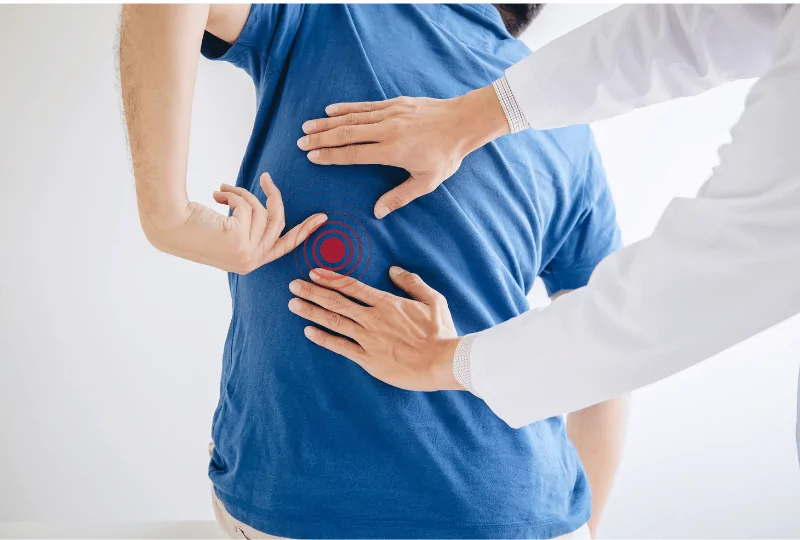



Lower left back pain affects a significant portion of adults, with low back pain commonly stemming from various injuries or organ-related issues. Understanding the causes and identifying emergencies in left lower back pain are crucial.
Causes
The back pain can be caused by many things, but these are the ones that happen most often.
Muscle Strain
Muscle strains happen when you do heavy lifting, twist too hard, or play rough sports. They can occur during simple tasks like moving boxes or from accidents like car crashes.
Strains happen when muscles stretch too much, causing inflammation and pain. This cause can include:
*Spasms
*Stiffness
*Reduced range of motion
Short-term lower back pain from muscle strain starts suddenly and may come with swelling, soreness, or bruising. Recovery time varies. Treat at home with rest, ice, heat, and over-the-counter meds or seek medical help if pain persists after a week or worsens.
Sciatica
Sciatica is back pain caused by inflammation of the sciatic nerve. It starts at the spine’s base, runs through the hips, buttocks, and down the leg. The pain can feel electric, burning, or tingly and is typically worse on one side. Prolonged sitting can aggravate it. Seek immediate medical attention if symptoms include difficulty urinating or numbness in the genital area.
To learn more about sciatic back pain, click on the following link for additional information.
Herniated or Slipped Disc
A herniated disc, also known as a slipped or ruptured disc, can cause severe lower back pain. These discs act as cushions between the bones of your spine, allowing flexibility. When one slips out of place due to heavy lifting or bending, it puts pressure on the spine nerves, leading to pain. Trauma, excessive activity, sedentary lifestyle, or being overweight can increase the risk. The pain’s location and type depend on the affected spine area; for instance, in the lower back, it may trigger sciatica by pressing on the sciatic nerve.
A herniated disc can also disrupt other muscles, nerves, or ligaments, resulting in symptoms such as:
*Pain in the area of the disc
*Pressure in the lower back
*Numbness or tingling in the back
*Numbness or tingling that happens in the legs or other areas affected by the nerve
Arthritis
Arthritis is a chronic disorder that makes joints hurt, swell, and get inflamed. Sometimes, it can also damage the bones and discs in the joints. It often makes the lower back hurt.
Other signs of arthritis may include:
*Spasms
*Stiffness
*Reduced range of motion
Sacroiliac Joint Dysfunction
The sacroiliac (SI) joints, situated in the pelvis where the sacrum meets the iliac bones, can lead to lower back and buttock pain, typically affecting one side. Pain in the lower left back may signify involvement of the left SI joint, making movements like walking, standing, or climbing stairs challenging. While some SI joint issues may resolve independently, others may require medical intervention such as physical therapy to alleviate symptoms and restore mobility.
Stress Fractures
Lower spine stress fractures can arise from various physical activities such as sports, weightlifting, or gymnastics, as well as from injuries like falls or car accidents. Older adults and individuals with conditions like osteoporosis face a higher risk. While these fractures may heal naturally within 6-8 weeks, they often necessitate medical attention due to severe pain, sometimes requiring prescription medication. Healthcare providers typically monitor the healing process closely.
Diagnosis
If experiencing left-sided low back pain, your healthcare provider will conduct a physical examination and diagnostic tests to identify the underlying cause of your discomfort.
Tests used to check lower left back pain might involve different methods:
*Blood tests are conducted to examine your blood count and organ function.
*Urine tests are done to detect signs of a kidney infection or kidney stone.
*CT scans, X-rays, ultrasounds, or MRIs are used to identify physical abnormalities or injuries.
Home Remedies
Some physicians will also suggest home remedies if the situation of your back pain is not severe. Below are some home remedies for you to try to alleviate the pain.
If your back pain is not severe, some doctors may recommend home remedies to alleviate discomfort. Here are a few you can try:
*Applying ice or heat packs to the affected area.
*Doing gentle stretches or exercises to strengthen the muscles.
*Taking over-the-counter pain relievers like ibuprofen or acetaminophen.
*Improving your posture and avoiding prolonged sitting or standing.
*Using supportive pillows or cushions while sitting or sleeping.
*Trying relaxation techniques such as deep breathing or meditation.
*Using orthopedic supports like back brace (LSO brace, TLSO brace)
Remember to consult with your healthcare provider before trying any new treatment or remedy. To obtain a back brace through your Medicare insurance, simply complete our contact form, and we’ll reach out to provide assistance. Alternatively, feel free to visit our store to explore the available back brace options.
When Is It An Emergency?
Lower left back pain can vary from mild discomfort to debilitating agony, hindering normal movement and function. If you experience a sudden onset of intense lower back pain, it’s crucial to seek emergency medical attention. For less severe pain persisting beyond 5-7 days, it’s advisable to seek medical care. Should your symptoms worsen, become severe, or if you develop accompanying symptoms like fever and chills, promptly visit the nearest medical facility and inform your healthcare provider.
Search Articles
Latest Articles
28th Feb, 24
23rd Feb, 24
20th Feb, 24
15th Feb, 24
13th Feb, 24



 888-616-4156
888-616-4156 


 28th Feb, 24
28th Feb, 24 

